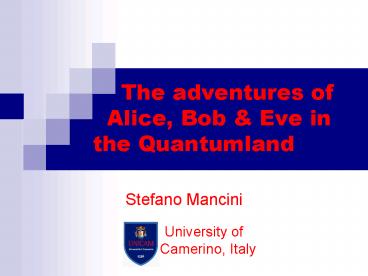Stefano Mancini - PowerPoint PPT Presentation
1 / 27
Title:
Stefano Mancini
Description:
QKD in infinite dimensional Hilbert space can make use of both coherent and entangled states Development of deterministic protocol in infinite dimensional Hilbert ... – PowerPoint PPT presentation
Number of Views:132
Avg rating:3.0/5.0
Title: Stefano Mancini
1
The adventures of Alice, Bob Eve in the
Quantumland
- Stefano Mancini
University of Camerino, Italy
2
Outline (part 3)
- From probabilistic to deterministic quantum
cryptography - From qubit to qudit up to cv
- Quantum Secret Sharing
- Beyond QKD Quantum bit commitment
- Conclusion
3
A general framework for deterministic
communication
Two way quantum channel Encoding by quantum
operation (Alice can encode without knowing the
state!)
Alphabetsstates
Encoding
Alice
Decoding
4
- Information relies on OPERATIONS upon the state
rather than on the STATE itself. This entails Eve
must perturb the quantum channel twice instead of
once to gain information - The protocol, for suitable alphabets states and
encoding/decoding operations, is DETERMINISTIC.
This feature also allows DIRECT COMMUNICATION. - How can Alice and Bob detect Eve? Use of two
modes MESSAGE MODE and CONTROL MODE - Possible use of non-orthogonal or entangled
alphabets states
5
A qubit protocol
(M. Lucamarini S. M. PRL 2005)
Simple intercept-resend eavesdropping
probability of detecting Eve (d) is (03/4)/2 vs
(01/2)/2 of BB84 !
6
Quantum Direct Communication
Number of message bits per protocol run 1-c Eve
wants to eavesdrop one message transfer without
being detected probability p(1-c)c(1-d)(1-c)
c2(1-d)2(1-c) Terms correspond to Eve having
survived 0,1,2 controls before she gets h(d)
bits of information After n successful attacks
Eve gains nh(d) bits and survive with probability
pn Probability to successfully eavesdrop nh(d)
bits Protocol asymptotically secure!
7
Eavesdropping success probability vs maximal
eavesdropping information
8
Eavesdropping in KD (individual incoherent
attack)
Distinguish between orthogonal
subspacesDistinguish between nonorthogonal
states
9
Lemma Optimal Eves incoherent attack consists
in a balanced one for which xx
10
Security conditions
dlt0.23 required vs dlt0.15 of BB84
11
Eavesdropping in KD (individual coherent attack)
12
Security conditions
dlt0.18 required vs dlt0.15 of BB84
13
Efficiency
Theoretical Efficiency Eub/(tqtb) E1-c BB84
E1/6 Practical Efficiency E accounts for
losses EEP2 BB84 EEP (P being the
probability to safely transmit a qubit over
Alice-Bob distance) For Pgt1/(6(1-c)) the scheme
surpasses BB84
14
What is about entanglement ?
- Bob uses a home qubit and a travel qubit in
one of the Bells states - Alice encodes by performing I,iY on travel
qubit - Bob decodes by performing Bells basis
measurement - Analogy with DENSE CODING !
- EQUIVALENCE with previous protocol (like BB84
E91)
15
From qubit to qudit up to cv
- Higher rates for QKD can be achieved by using
larger alphabets (Hilbert spaces) - Extension of BB84 to qudit (use MUB)
- Extension of E91 to qudit (generalized Bell
ineq.) - QKD in infinite dimensional Hilbert space can
make use of both coherent and entangled states - Development of deterministic protocol in infinite
dimensional Hilbert space - multi way quantum
communication (S. Pirandola, S. M. S. Lloyd
2006)
16
Quantum Secret Sharing
17
GHZ States and Secret Sharing
18
(No Transcript)
19
The security proof
20
(No Transcript)
21
Beyond QKD ?
- In a two-party computation Alice (Bob) has a
private input x (y) and would like to help Bob to
compute a prescribed function f(x,y) without
revealing x. - Bit commitment is a primitive for implementing
secure computations. - What is bit commitment ?
22
Procedure of quantum bit commitment
23
(No Transcript)
24
(No Transcript)
25
Information theoretic approach to QT
- Quantum theory can be viewed not as a
mechanical theory of waves and particles but as a
theory about the possibilities and
impossibilities of information transfer - The impossibility of superluminal information
transfer - The impossibility of perfectly broadcasting
information contained in an unknown state (no
cloning) - The impossibility of unconditionally secure bit
commitment
26
the final questions
- What is the exact boundary of quantum
cryptography and why is there ? - How would governments regulate quantum
cryptography ?
27
A Short Bibliography
- S. Singh, The Code Book (Anchor Book, 1999)
- H. K. Lo, Quantum Cryptology (in Introduction to
Quantum Computation Information, World
Scientific, 1998) - S. Lomonaco, How Alice outwits Eve (in Lecture
Notes in Computer Science, Springer 1999) - N. Gisin et al., RMP 2002
- A. Galindo M. Martin-Delgado, RMP 2002
Further information and research at UniCam see
http//fisica.unicam.it/stefano.mancinior
contact me at stefano.mancini_at_unicam.it






























